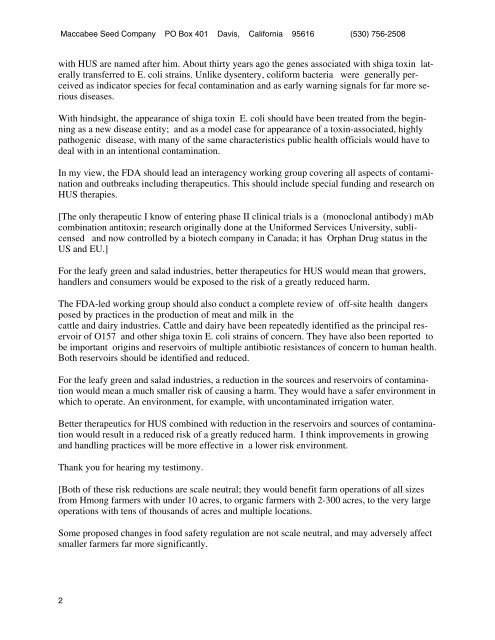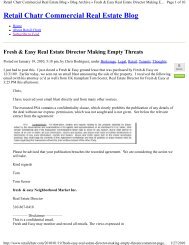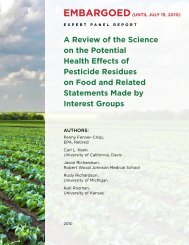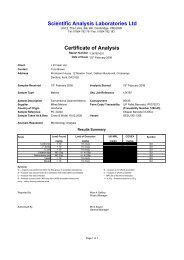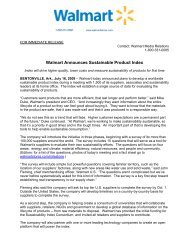Written Testimony - Perishable Pundit
Written Testimony - Perishable Pundit
Written Testimony - Perishable Pundit
Create successful ePaper yourself
Turn your PDF publications into a flip-book with our unique Google optimized e-Paper software.
Maccabee Seed Company PO Box 401 Davis, California 95616 (530) 756-2508<br />
with HUS are named after him. About thirty years ago the genes associated with shiga toxin laterally<br />
transferred to E. coli strains. Unlike dysentery, coliform bacteria were generally perceived<br />
as indicator species for fecal contamination and as early warning signals for far more serious<br />
diseases.<br />
With hindsight, the appearance of shiga toxin E. coli should have been treated from the beginning<br />
as a new disease entity; and as a model case for appearance of a toxin-associated, highly<br />
pathogenic disease, with many of the same characteristics public health officials would have to<br />
deal with in an intentional contamination.<br />
In my view, the FDA should lead an interagency working group covering all aspects of contamination<br />
and outbreaks including therapeutics. This should include special funding and research on<br />
HUS therapies.<br />
[The only therapeutic I know of entering phase II clinical trials is a (monoclonal antibody) mAb<br />
combination antitoxin; research originally done at the Uniformed Services University, sublicensed<br />
and now controlled by a biotech company in Canada; it has Orphan Drug status in the<br />
US and EU.]<br />
For the leafy green and salad industries, better therapeutics for HUS would mean that growers,<br />
handlers and consumers would be exposed to the risk of a greatly reduced harm.<br />
The FDA-led working group should also conduct a complete review of off-site health dangers<br />
posed by practices in the production of meat and milk in the<br />
cattle and dairy industries. Cattle and dairy have been repeatedly identified as the principal reservoir<br />
of O157 and other shiga toxin E. coli strains of concern. They have also been reported to<br />
be important origins and reservoirs of multiple antibiotic resistances of concern to human health.<br />
Both reservoirs should be identified and reduced.<br />
For the leafy green and salad industries, a reduction in the sources and reservoirs of contamination<br />
would mean a much smaller risk of causing a harm. They would have a safer environment in<br />
which to operate. An environment, for example, with uncontaminated irrigation water.<br />
Better therapeutics for HUS combined with reduction in the reservoirs and sources of contamination<br />
would result in a reduced risk of a greatly reduced harm. I think improvements in growing<br />
and handling practices will be more effective in a lower risk environment.<br />
Thank you for hearing my testimony.<br />
[Both of these risk reductions are scale neutral; they would benefit farm operations of all sizes<br />
from Hmong farmers with under 10 acres, to organic farmers with 2-300 acres, to the very large<br />
operations with tens of thousands of acres and multiple locations.<br />
Some proposed changes in food safety regulation are not scale neutral, and may adversely affect<br />
smaller farmers far more significantly.<br />
2


